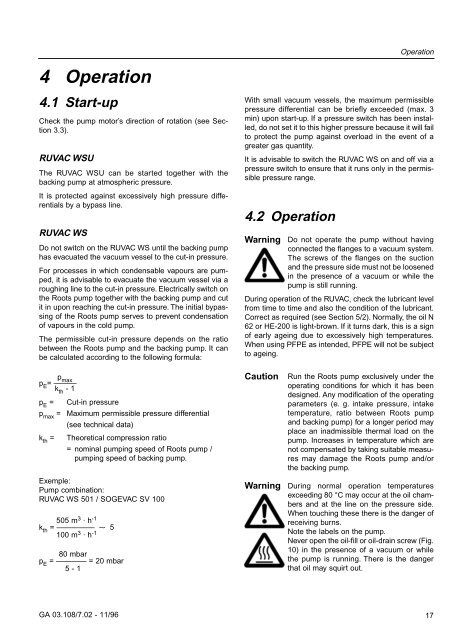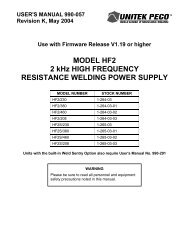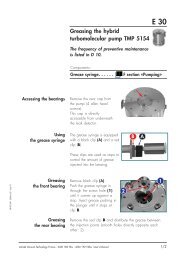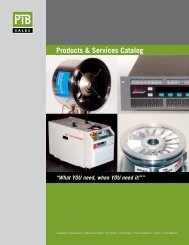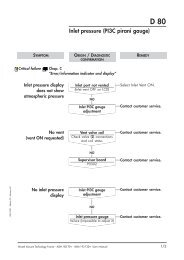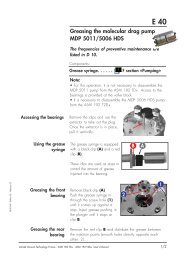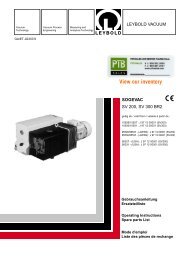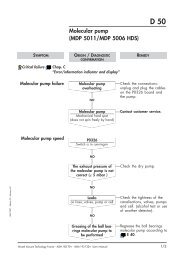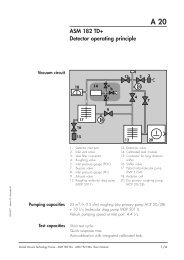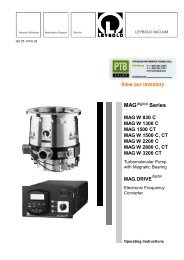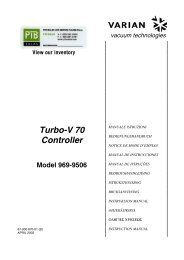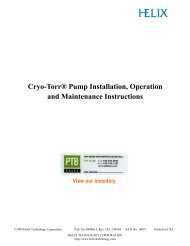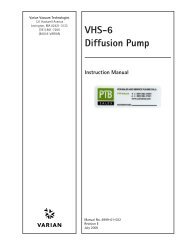Leybold WS151 Roots Blower Manual - REMRSEC Facilities
Leybold WS151 Roots Blower Manual - REMRSEC Facilities
Leybold WS151 Roots Blower Manual - REMRSEC Facilities
You also want an ePaper? Increase the reach of your titles
YUMPU automatically turns print PDFs into web optimized ePapers that Google loves.
Operation<br />
4 Operation<br />
4.1 Start-up<br />
Check the pump motor’s direction of rotation (see Section<br />
3.3).<br />
RUVAC WSU<br />
The RUVAC WSU can be started together with the<br />
backing pump at atmospheric pressure.<br />
It is protected against excessively high pressure differentials<br />
by a bypass line.<br />
RUVAC WS<br />
Do not switch on the RUVAC WS until the backing pump<br />
has evacuated the vacuum vessel to the cut-in pressure.<br />
For processes in which condensable vapours are pumped,<br />
it is advisable to evacuate the vacuum vessel via a<br />
roughing line to the cut-in pressure. Electrically switch on<br />
the <strong>Roots</strong> pump together with the backing pump and cut<br />
it in upon reaching the cut-in pressure. The initial bypassing<br />
of the <strong>Roots</strong> pump serves to prevent condensation<br />
of vapours in the cold pump.<br />
The permissible cut-in pressure depends on the ratio<br />
between the <strong>Roots</strong> pump and the backing pump. It can<br />
be calculated according to the following formula:<br />
With small vacuum vessels, the maximum permissible<br />
pressure differential can be briefly exceeded (max. 3<br />
min) upon start-up. If a pressure switch has been installed,<br />
do not set it to this higher pressure because it will fail<br />
to protect the pump against overload in the event of a<br />
greater gas quantity.<br />
It is advisable to switch the RUVAC WS on and off via a<br />
pressure switch to ensure that it runs only in the permissible<br />
pressure range.<br />
4.2 Operation<br />
Warning<br />
Do not operate the pump without having<br />
connected the flanges to a vacuum system.<br />
The screws of the flanges on the suction<br />
and the pressure side must not be loosened<br />
in the presence of a vacuum or while the<br />
pump is still running.<br />
During operation of the RUVAC, check the lubricant level<br />
from time to time and also the condition of the lubricant.<br />
Correct as required (see Section 5/2). Normally, the oil N<br />
62 or HE-200 is light-brown. If it turns dark, this is a sign<br />
of early ageing due to excessively high temperatures.<br />
When using PFPE as intended, PFPE will not be subject<br />
to ageing.<br />
p max<br />
p E<br />
= ———<br />
k th<br />
- 1<br />
p E<br />
=<br />
p max<br />
=<br />
k th<br />
=<br />
Cut-in pressure<br />
Maximum permissible pressure differential<br />
(see technical data)<br />
Theoretical compression ratio<br />
= nominal pumping speed of <strong>Roots</strong> pump /<br />
pumping speed of backing pump.<br />
Exemple:<br />
Pump combination:<br />
RUVAC WS 501 / SOGEVAC SV 100<br />
505 m 3 · h -1<br />
k th<br />
= ————— 1 5<br />
100 m 3 · h -1<br />
80 mbar<br />
p E<br />
= ———— = 20 mbar<br />
5 - 1<br />
Caution<br />
Warning<br />
Run the <strong>Roots</strong> pump exclusively under the<br />
operating conditions for which it has been<br />
designed. Any modification of the operating<br />
parameters (e. g. intake pressure, intake<br />
temperature, ratio between <strong>Roots</strong> pump<br />
and backing pump) for a longer period may<br />
place an inadmissible thermal load on the<br />
pump. Increases in temperature which are<br />
not compensated by taking suitable measures<br />
may damage the <strong>Roots</strong> pump and/or<br />
the backing pump.<br />
During normal operation temperatures<br />
exceeding 80 °C may occur at the oil chambers<br />
and at the line on the pressure side.<br />
When touching these there is the danger of<br />
receiving burns.<br />
Note the labels on the pump.<br />
Never open the oil-fill or oil-drain screw (Fig.<br />
10) in the presence of a vacuum or while<br />
the pump is running. There is the danger<br />
that oil may squirt out.<br />
GA 03.108/7.02 - 11/96<br />
17


